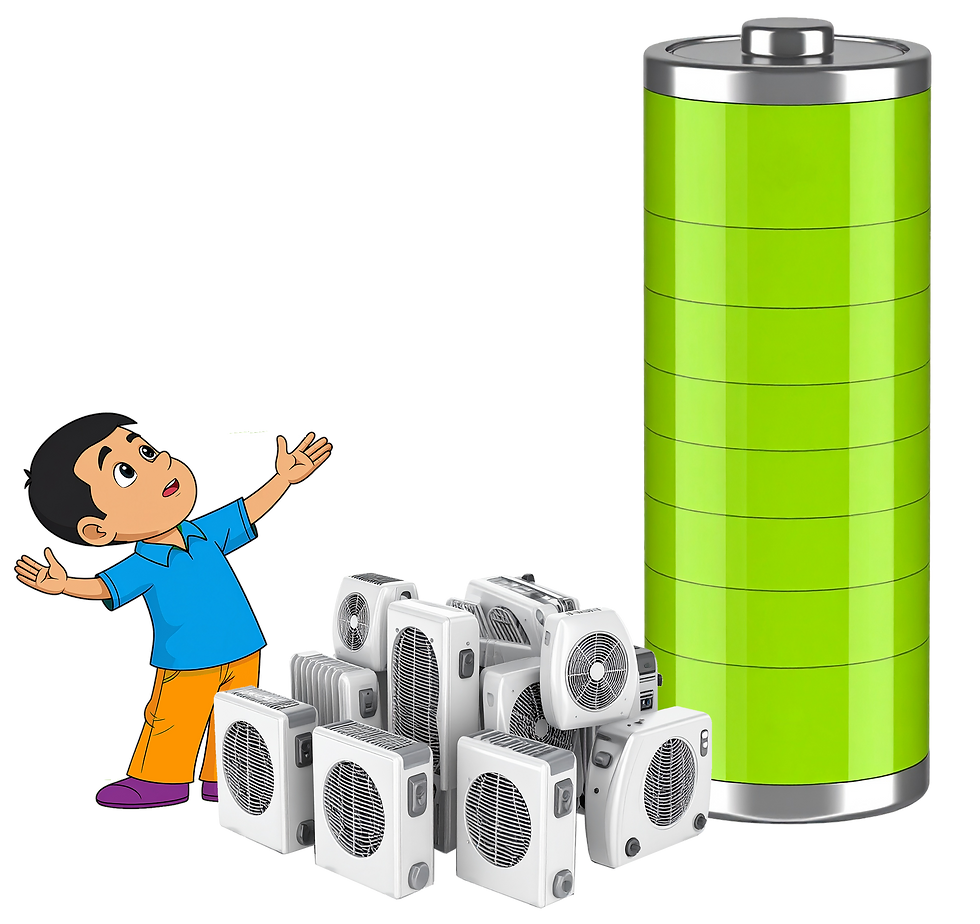The Electric Bus Heating Dilemma Part 1: Understanding the Issues
- Jeremy Sanger
- Jul 22
- 4 min read
Updated: Aug 21
Just the basic facts
Generally speaking, combustion engines produce three things:
1. Power/Force/Torque – to make a vehicle move.
2. Exhaust – toxic substances resulting from burning fuel.
3. Waste Heat – an unavoidable result of the combustion process.
Note: For passenger vehicles in cold climates, a combustion engine’s “waste heat” is used to keep windows defrosted and warm the passenger compartment. However, the waste heat from an engine is usually not enough to heat an entire bus.
Generally speaking, electric motors produce only two things:
1. Power/Force/Torque – to make a vehicle move.
2. Just a little bit of waste heat.
Both humans and EV batteries like to be kept at about the same temperature. In cold climates, an EV drive system doesn’t produce enough heat to keep its own batteries warm, let alone a small car, and definitely not an entire bus. A supplemental heating source is necessary.
The Cold Truth
What are the most “traditional” and the most “obvious” solutions for heating a bus?

Fuel-fired Heaters (FFH) are the traditional solution for supplemental bus heat. Electric heaters (including PTC and heat pumps) are seemingly the most obvious candidates for EVs. However, for several reasons, electric heaters aren't ideal as the only source of heat. Meanwhile, FFH heaters seriously miss the mark as supplemental heat for electric vehicles.
The illustration shows a fuel-fired heater (FFH) on a diesel bus. As you can see, there is a full automobile-sized exhaust pipe sticking out from under the bus in order to evacuate raw (untreated) diesel exhaust created by the diesel burners on the heater.
Fuel-fired Heaters (FFH) are the traditional choice as supplemental heat sources for diesel vehicles. An FFH can generate a lot of heat, but it does so by using a raw flame that consumes diesel fuel and expels untreated diesel exhaust from the side of the bus. Also, emissions continue to worsen over time of the nozzles are not regularly maintained. If your goal is a more efficient, cleaner, less expensive, and easier-to-maintain transportation system, heating your bus with an FFH is not even an option.
Electric heaters are quite efficient in some circumstances, but they lose their advantages when heating a large space with power from a big traction battery that is also responsible for propulsion. Why? Two main reasons:
Reduced Efficiency: A critical limiting factor for electric heaters is the energy loss that occurs during the battery charging process and subsequent conversion of the charge into energy to create heat. That is, whenever electricity is transferred and/or converted from one type of current to another, the system will encounter limitations and energy loss.

The illustration above shows the energy path required to provide electric heat for the passenger compartment on an EV bus. While the heating element is efficient, there will be losses during energy regeneration, inversion, and distribution.
For example, the efficiency gained from regenerative braking is negatively affected by cold temperatures. A Cornell University report, published on May 28, 2025, in The Cornell Chronicle, stated that, “…regenerative braking … was also less efficient in cold weather. … likely because the battery … struggles to maintain an even temperature across its cells.”
Multiple Heating Requirements: Both the passengers and the EV batteries must be kept warm. The same Cornell University report mentioned above points out that “…the batteries on the electric buses consumed 48% more energy in cold weather.” And “half the increased [energy] consumption in cold weather comes from the batteries’ need to heat themselves.”
Basically, heating a bus’s EV traction battery, as well as maintaining comfortable temperatures in the passenger compartment of a large bus, requires a significant amount of energy.

Let's break it down into something easier to understand – electric space heaters.
That little space heater you have under your desk at the office puts out 900 to 1500 watts or 3,071 to 5,118 BTU/hr. An easy calculation since kilowatts can be converted directly to BTU/hr.: 1 kilowatt = 3,412 BTU/hr.
If we consider a hypothetical Type C Bus with 13 rows of seats, and we assume we need one space heater for each row, that’s 40,000 to 66,000 BTU/hr. just to warm the passengers on the bus. Around 12 to 20 kilowatts of thermal power required for the passengers alone.
The Cornell study mentioned above said that half of an EV bus’s heating demands are for heating the bus, and the other half for heating the batteries. That means you need another 12 to 20 kilowatts to keep the battery warm.
A total of 24 to 40 kilowatts every hour, required to achieve the minimal heating requirements. In cold weather, a battery cannot practically deliver upon this requirement for heat and concurrently provide for normal propulsion needs. Even in short-distance runs, this situation would place great strain on the battery system.

What is to be done?
“Please, sir, I want some more.”
What about just putting in more electric heaters and a bigger battery?
We’ll talk about that option and a better answer in Part Two: A Practical Solution.



Comments